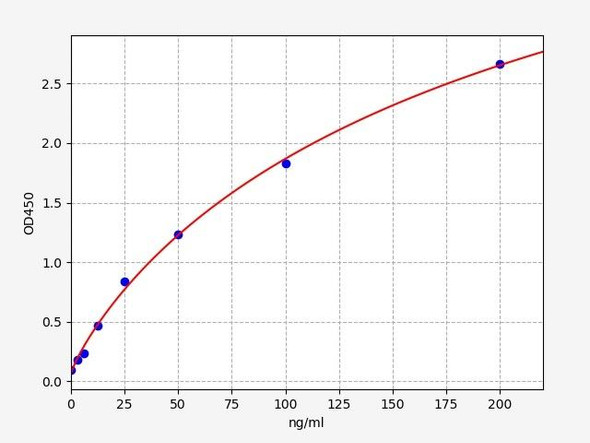Description
Mouse Coagulation factor XII (F12) ELISA Kit
The Mouse Coagulation Factor XII (F12) ELISA Kit is a specialized assay designed for the accurate and reliable detection of mouse coagulation factor XII levels in serum, plasma, and cell culture supernatants. This kit offers high sensitivity and specificity, ensuring precise and reproducible results for research applications.Coagulation factor XII is a key protein involved in the blood clotting cascade, playing a crucial role in hemostasis and thrombosis. Dysregulation of factor XII has been implicated in various diseases including thrombosis, inflammatory disorders, and cardiovascular conditions, highlighting its importance as a biomarker for research and therapeutic development.
With its advanced technology and user-friendly format, the Mouse Coagulation Factor XII (F12) ELISA Kit is an essential tool for studying the role of factor XII in disease pathology and evaluating potential interventions for related disorders.
| Product Name: | Mouse Coagulation factor XII (F12) ELISA Kit |
| SKU: | MOEB0541 |
| Size: | 96T |
| Target: | Mouse Coagulation factor XII (F12) |
| Synonyms: | Hageman factor, HAF |
| Assay Type: | Sandwich |
| Detection Method: | ELISA |
| Reactivity: | Mouse |
| Detection Range: | 0.312-20ng/mL |
| Sensitivity: | 0.164ng/mL |
| Intra CV: | Provided with the Kit |
| Inter CV: | Provided with the Kit |
| Linearity: | Provided with the Kit |
| Recovery: | Provided with the Kit |
| Function: | Factor XII is a serum glycoprotein that participates in the initiation of blood coagulation, fibrinolysis, and the generation of bradykinin and angiotensin. Prekallikrein is cleaved by factor XII to form kallikrein, which then cleaves factor XII first to alpha-factor XIIa and then trypsin cleaves it to beta-factor XIIa. Alpha-factor XIIa activates factor XI to factor XIa. |
| Uniprot: | Q80YC5 |
| Sample Type: | Serum, plasma, tissue homogenates, cell culture supernates and other biological fluids |
| Specificity: | Natural and recombinant mouse Coagulation factor XII |
| Sub Unit: | Interacts with HRG; the interaction, which is enhanced in the presence of zinc ions and inhibited by heparin-binding, inhibits factor XII autoactivation and contact-initiated coagulation. |
| Subcellular Location: | Secreted |
| Storage: | Please see kit components below for exact storage details |
| Note: | For research use only |
| UniProt Protein Function: | F12: Factor XII is a serum glycoprotein that participates in the initiation of blood coagulation, fibrinolysis, and the generation of bradykinin and angiotensin. Prekallikrein is cleaved by factor XII to form kallikrein, which then cleaves factor XII first to alpha-factor XIIa and then trypsin cleaves it to beta- factor XIIa. Alpha-factor XIIa activates factor XI to factor XIa. Defects in F12 are the cause of factor XII deficiency (FA12D); also known as Hageman factor deficiency. This trait is an asymptomatic anomaly of in vitro blood coagulation. Its diagnosis is based on finding a low plasma activity of the factor in coagulating assays. It is usually only accidentally discovered through pre-operative blood tests. F12 deficiency is divided into two categories, a cross-reacting material (CRM)-negative group (negative F12 antigen detection) and a CRM-positive group (positive F12 antigen detection). Defects in F12 are the cause of hereditary angioedema type 3 (HAE3); also known as estrogen-related HAE or hereditary angioneurotic edema with normal C1 inhibitor concentration and function. HAE is characterized by episodic local subcutaneous edema, and submucosal edema involving the upper respiratory and gastrointestinal tracts. HAE3 occurs exclusively in women and is precipitated or worsened by high estrogen levels (e.g. during pregnancy or treatment with oral contraceptives). It differs from HAE types 1 and 2 in that both concentration and function of C1 inhibitor are normal. Belongs to the peptidase S1 family. |
| UniProt Protein Details: | Protein type:Protease; Secreted; Chaperone; EC 3.4.21.38; Secreted, signal peptide Cellular Component: extracellular space; extracellular region Molecular Function:peptidase activity; hydrolase activity; serine-type peptidase activity; serine-type endopeptidase activity; catalytic activity Biological Process: response to misfolded protein; positive regulation of blood coagulation; proteolysis; protein autoprocessing; fibrinolysis; hemostasis; plasma kallikrein-kinin cascade; regulation of blood coagulation; positive regulation of fibrinolysis; zymogen activation; protein processing; blood coagulation; Factor XII activation |
| NCBI Summary: | This gene encodes a glycoprotein coagulation factor that plays an important role in the intrinsic pathway of blood coagulation and hemostasis. The encoded protein is an inactive zymogen that is autoactivated upon contact with negatively charged surfaces or misfolded protein aggregates. Mice lacking the encoded protein have a severe defect in forming stable fibrin clots. [provided by RefSeq, Apr 2015] |
| UniProt Code: | Q80YC5 |
| NCBI GenInfo Identifier: | 171906584 |
| NCBI Gene ID: | 58992 |
| NCBI Accession: | NP_067464.2 |
| UniProt Secondary Accession: | Q80YC5,O35727, Q6PER0, |
| UniProt Related Accession: | Q80YC5 |
| Molecular Weight: | 75,000 (Approximate) |
| NCBI Full Name: | coagulation factor XII |
| NCBI Synonym Full Names: | coagulation factor XII (Hageman factor) |
| NCBI Official Symbol: | F12 |
| NCBI Official Synonym Symbols: | HAF; FXII |
| NCBI Protein Information: | coagulation factor XII; hageman factor |
| UniProt Protein Name: | Coagulation factor XII |
| UniProt Synonym Protein Names: | Hageman factor |
| Protein Family: | Coagulation factor |
| UniProt Gene Name: | F12 |
| UniProt Entry Name: | FA12_MOUSE |
| Component | Quantity (96 Assays) | Storage |
| ELISA Microplate (Dismountable) | 8×12 strips | -20°C |
| Lyophilized Standard | 2 | -20°C |
| Sample Diluent | 20ml | -20°C |
| Assay Diluent A | 10mL | -20°C |
| Assay Diluent B | 10mL | -20°C |
| Detection Reagent A | 120µL | -20°C |
| Detection Reagent B | 120µL | -20°C |
| Wash Buffer | 30mL | 4°C |
| Substrate | 10mL | 4°C |
| Stop Solution | 10mL | 4°C |
| Plate Sealer | 5 | - |
Other materials and equipment required:
- Microplate reader with 450 nm wavelength filter
- Multichannel Pipette, Pipette, microcentrifuge tubes and disposable pipette tips
- Incubator
- Deionized or distilled water
- Absorbent paper
- Buffer resevoir
*Note: The below protocol is a sample protocol. Protocols are specific to each batch/lot. For the correct instructions please follow the protocol included in your kit.
Allow all reagents to reach room temperature (Please do not dissolve the reagents at 37°C directly). All the reagents should be mixed thoroughly by gently swirling before pipetting. Avoid foaming. Keep appropriate numbers of strips for 1 experiment and remove extra strips from microtiter plate. Removed strips should be resealed and stored at -20°C until the kits expiry date. Prepare all reagents, working standards and samples as directed in the previous sections. Please predict the concentration before assaying. If values for these are not within the range of the standard curve, users must determine the optimal sample dilutions for their experiments. We recommend running all samples in duplicate.
| Step | |
| 1. | Add Sample: Add 100µL of Standard, Blank, or Sample per well. The blank well is added with Sample diluent. Solutions are added to the bottom of micro ELISA plate well, avoid inside wall touching and foaming as possible. Mix it gently. Cover the plate with sealer we provided. Incubate for 120 minutes at 37°C. |
| 2. | Remove the liquid from each well, don't wash. Add 100µL of Detection Reagent A working solution to each well. Cover with the Plate sealer. Gently tap the plate to ensure thorough mixing. Incubate for 1 hour at 37°C. Note: if Detection Reagent A appears cloudy warm to room temperature until solution is uniform. |
| 3. | Aspirate each well and wash, repeating the process three times. Wash by filling each well with Wash Buffer (approximately 400µL) (a squirt bottle, multi-channel pipette,manifold dispenser or automated washer are needed). Complete removal of liquid at each step is essential. After the last wash, completely remove remaining Wash Buffer by aspirating or decanting. Invert the plate and pat it against thick clean absorbent paper. |
| 4. | Add 100µL of Detection Reagent B working solution to each well. Cover with the Plate sealer. Incubate for 60 minutes at 37°C. |
| 5. | Repeat the wash process for five times as conducted in step 3. |
| 6. | Add 90µL of Substrate Solution to each well. Cover with a new Plate sealer and incubate for 10-20 minutes at 37°C. Protect the plate from light. The reaction time can be shortened or extended according to the actual color change, but this should not exceed more than 30 minutes. When apparent gradient appears in standard wells, user should terminatethe reaction. |
| 7. | Add 50µL of Stop Solution to each well. If color change does not appear uniform, gently tap the plate to ensure thorough mixing. |
| 8. | Determine the optical density (OD value) of each well at once, using a micro-plate reader set to 450 nm. User should open the micro-plate reader in advance, preheat the instrument, and set the testing parameters. |
| 9. | After experiment, store all reagents according to the specified storage temperature respectively until their expiry. |
When carrying out an ELISA assay it is important to prepare your samples in order to achieve the best possible results. Below we have a list of procedures for the preparation of samples for different sample types.
| Sample Type | Protocol |
| Serum | If using serum separator tubes, allow samples to clot for 30 minutes at room temperature. Centrifuge for 10 minutes at 1,000x g. Collect the serum fraction and assay promptly or aliquot and store the samples at -80°C. Avoid multiple freeze-thaw cycles. If serum separator tubes are not being used, allow samples to clot overnight at 2-8°C. Centrifuge for 10 minutes at 1,000x g. Remove serum and assay promptly or aliquot and store the samples at -80°C. Avoid multiple freeze-thaw cycles. |
| Plasma | Collect plasma using EDTA or heparin as an anticoagulant. Centrifuge samples at 4°C for 15 mins at 1000 × g within 30 mins of collection. Collect the plasma fraction and assay promptly or aliquot and store the samples at -80°C. Avoid multiple freeze-thaw cycles. Note: Over haemolysed samples are not suitable for use with this kit. |
| Urine & Cerebrospinal Fluid | Collect the urine (mid-stream) in a sterile container, centrifuge for 20 mins at 2000-3000 rpm. Remove supernatant and assay immediately. If any precipitation is detected, repeat the centrifugation step. A similar protocol can be used for cerebrospinal fluid. |
| Cell culture supernatant | Collect the cell culture media by pipette, followed by centrifugation at 4°C for 20 mins at 1500 rpm. Collect the clear supernatant and assay immediately. |
| Cell lysates | Solubilize cells in lysis buffer and allow to sit on ice for 30 minutes. Centrifuge tubes at 14,000 x g for 5 minutes to remove insoluble material. Aliquot the supernatant into a new tube and discard the remaining whole cell extract. Quantify total protein concentration using a total protein assay. Assay immediately or aliquot and store at ≤ -20 °C. |
| Tissue homogenates | The preparation of tissue homogenates will vary depending upon tissue type. Rinse tissue with 1X PBS to remove excess blood & homogenize in 20ml of 1X PBS (including protease inhibitors) and store overnight at ≤ -20°C. Two freeze-thaw cycles are required to break the cell membranes. To further disrupt the cell membranes you can sonicate the samples. Centrifuge homogenates for 5 mins at 5000xg. Remove the supernatant and assay immediately or aliquot and store at -20°C or -80°C. |
| Tissue lysates | Rinse tissue with PBS, cut into 1-2 mm pieces, and homogenize with a tissue homogenizer in PBS. Add an equal volume of RIPA buffer containing protease inhibitors and lyse tissues at room temperature for 30 minutes with gentle agitation. Centrifuge to remove debris. Quantify total protein concentration using a total protein assay. Assay immediately or aliquot and store at ≤ -20 °C. |
| Breast Milk | Collect milk samples and centrifuge at 10,000 x g for 60 min at 4°C. Aliquot the supernatant and assay. For long term use, store samples at -80°C. Minimize freeze/thaw cycles. |








